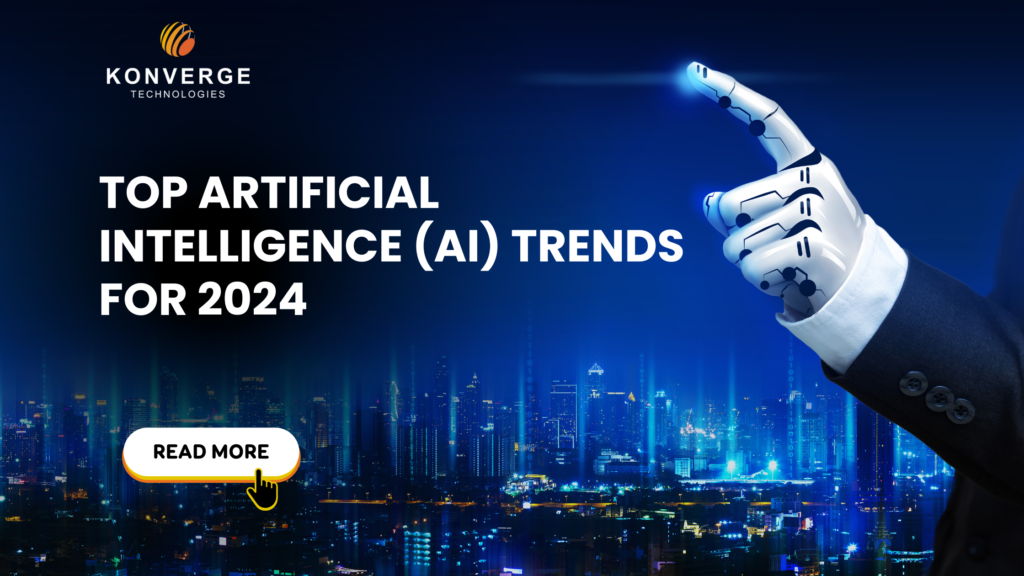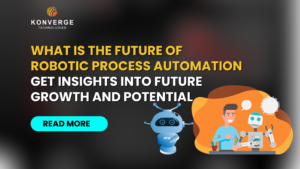
Top Artificial Intelligence (AI) Trends for 2024

Introduction:
As we look towards the future of 2024 and beyond, artificial intelligence is rapidly advancing and transforming various industries and aspects of daily life. Generative AI, a key driver in this technological revolution, straddles the line between the peak hype it has generated and the practical disillusionment that often follows early excitement. As stewards of Konverge Technologies, we recognize that while the transformative impact of these AI trends is significant, it’s important to manage expectations—generative AI won’t be the panacea for all, but rather a tool offering niche solutions and opportunities.
In navigating the upcoming waves of change within the AI landscape, our focus shifts to discerning the true value behind buzzwords like machine learning, deep learning, and neural networks. This article will chart the course of generative AI’s influence, the industrialization of data science, and the rising prominence of data products. We’ll examine the evolving role of data scientists, the increasing necessity for AI-savvy leadership, and the burgeoning significance of open-source and external AI models, all of which are poised to reshape the contours of business and technology.
Generative AI’s Increasing Impact
As we cast our eyes toward the horizon of 2024, Generative AI’s influence is burgeoning, and its impact on various industries is becoming more pronounced. Here’s how:
Open Source AI Models Gain Ground:
- Open-source AI models are catching up with proprietary counterparts, like Google’s Bard and OpenAI’s ChatGPT, in capability and accessibility.
- MistralAI’s Mixtral, a competitive open-source Large Language Model (LLM), exemplifies the rapid deployment and cost-efficiency of open models.
- The open-source approach is fostering a collaborative environment where developers build upon each other’s work, democratizing AI access and reducing costs.
Enhancements in AI Accuracy and Applications:
- Retrieval-augmented Generation (RAG) is a notable advancement, curtailing hallucinations in AI-generated content to bolster its precision and relevance.
- Generative AI is on the cusp of revolutionizing content creation, with applications spanning marketing to media, promising enhanced efficiency and scalability.
- Beyond content, AI tools are expected to expedite scientific breakthroughs, tackling global challenges like climate change and health crises.
Economic Impact and Ethical Considerations:
- The economic footprint of Generative AI is immense, with projections seeing the market grow to $667.96 billion by 2030, at a CAGR of 47.5%.
- As AI becomes more intuitive and user-friendly, it’s breaking down barriers to machine interaction, but not without raising ethical questions regarding privacy and bias.
- For businesses, the integration of Generative AI could automate and optimize operations, spurring innovation and competitiveness.
In our journey, we recognize that while Generative AI harbors transformative potential, the path is paved with challenges like data privacy and the ethical use of AI. It’s a journey we embrace with a clear-eyed view of its vast possibilities and the responsibilities it entails.
Shift from Data Science Artisanal to Industrial
At Konverge Technologies, we’re observing a pivotal shift in the field of data science. This transition is marked by the movement from a craft-based approach to a more systematic, industrial process. Here’s how this evolution is unfolding:
Accessibility of Tools:
- AI/ML technologies are becoming more user-friendly, enabling product managers and teams to harness these tools without deep technical expertise.
- To address the growing demand for AI and ML skills, we’re focusing on nurturing talent and forming strategic partnerships to bridge the skills gap.
Efficiency in Model Development:
- The trend is shifting towards smaller, more efficient models that offer the dual benefits of local deployment on devices and enhanced explainability.
- Open-source models like Mixtral are gaining traction, outperforming larger counterparts in benchmarks with quicker inference speeds.
Industrialization of Data Science:
- We’re investing in platforms and methodologies that streamline the production of data science models, shifting from bespoke creations to a more standardized, repeatable process.
- Emphasizing the reuse of data sets, features, and models, we’re significantly boosting productivity and accelerating deployment rates in the field.
By embracing these trends, we’re not only improving our operational efficiency but also democratizing AI, making it more accessible and understandable for a broader audience.
The Rise of Data Products
In the dynamic world of data products, we’re witnessing a bifurcation in their development. On one hand, there are products integrated with analytics and AI capabilities, and on the other, products that treat these technologies as standalone features. This distinction is critical for us as it guides our product development strategies:
Integration of Multimodal AI:
- We’re leveraging multimodal AI to process a variety of data inputs, such as text, images, and sound, thereby enriching the data pool available for training our models.
- The focus is on mimicking human sensory processing to provide a more comprehensive understanding of data.
Advancements in Model Optimization:
- Thanks to the open-source community, model optimization is becoming more accessible, allowing us to refine pre-trained models with techniques like LoRA, quantization, and DPO.
- These advancements enable us to offer sophisticated AI capabilities, even as a smaller player in the market.
Customization of Local Models:
- We’re developing bespoke models and data pipelines tailored to specific real-world scenarios, ensuring that our data products stand out in niche markets.
- Customized enterprise generative AI models are particularly beneficial in sectors with specialized terminology and practices, allowing us to meet unique user needs.
Changing Role of Data Scientists
In the ever-evolving realm of data science, we are witnessing a transformation in the role of data scientists, shaped by advances in AI and the rise of new roles. Here’s what this change looks like:
Shift in Demand and Role Expansion:
- The allure of the traditional data scientist role is evolving as the field sees an influx of specialized roles such as data engineers and machine learning engineers.
- Data scientists now often wear multiple hats, transitioning to roles like translators and connectors, or data product managers, to address specific aspects of the data science pipeline.
Empowerment through Automation:
- Automated machine learning tools, including platforms like ChatGPT’s Advanced Data Analysis, are democratizing data science, enabling quantitatively savvy business professionals to perform data science tasks.
- This rise of citizen data science is contributing to a shift in demand, as more individuals can engage in data science without extensive professional expertise.
The Evolving Synergy of Humans and AI:
- While AI is automating tasks such as data preparation and visualization, the unique value of human data scientists remains irreplaceable, especially in areas requiring domain expertise, critical thinking, and strategic oversight.
- We’re moving towards a collaborative future where hybrid human-AI teams will enhance productivity and innovation, allowing data scientists to focus on high-value tasks that drive key business objectives.
Leadership in AI and Analytics Becoming Integral
As we look ahead to 2024, we’re cognizant of the transformative role AI and analytics leadership will play in steering companies through the AI revolution. The landscape is rapidly changing, and here’s how leadership roles are evolving:
Evolving Leadership Roles:
- With AI becoming as ubiquitous as the Internet, the roles of data, analytics, and AI leaders are being redefined. No longer operating in silos, these leaders are becoming integral parts of a unified tech leadership.
- The Chief Data Officer (CDO) role, once distinct, now often encompasses analytics and AI, reflecting the intertwined nature of these disciplines.
- A new trend is the emergence of the Chief Artificial Intelligence Officer (CAIO), with organizations actively recruiting for this role to navigate the AI-driven business landscape.
Strategic Integration of AI Leadership:
- Data and AI are increasingly viewed as core business responsibilities, with executive roles evolving to report directly to the CEO or COO. This shift signifies the strategic importance of AI in decision-making.
- Regular presentations to corporate boards by data and AI leaders are becoming the norm, ensuring that boards are educated on AI’s opportunities and risks.
Cultural and Organizational Adaptation:
- Addressing cultural challenges is paramount, requiring a transformational approach and new skill sets within the organization.
- Leaders must foster an environment that breaks down data silos and promotes data literacy, ensuring a nuanced approach to integrating AI into business processes.
In this critical period of advancement, our leadership is dedicated to ensuring a robust data foundation and a culture adaptive to AI integration, setting the stage for successful implementation and innovation.
The Emergence and Role of Open Source and External AI Models
As we continue to pioneer the AI landscape at Konverge Technologies, the role of open-source and external AI models is becoming increasingly significant. Here’s how this trend is unfolding:
Advancing Ethical AI through Transparency:
- Open-source AI models like Mistral’s Mixtral provide a window into the model’s inner workings, fostering responsible AI practices by ensuring ethical guidelines are in place.
- The transparency inherent in open-source development is crucial for our commitment to ethical AI, as it allows for scrutiny and assurance that models align with our values.
Harnessing Global Innovation through Collaboration:
- The open-source AI ecosystem thrives on global contributions, which bring diverse perspectives and drive innovation.
- Collaborations, such as IBM and NASA’s joint effort on a geospatial AI model, show the power of open source to tackle global issues like climate change.
Navigating the Open Source Landscape:
- Despite challenges, the open-source AI community is expanding, propelled by the need for AI models that are accessible and not confined by corporate interests.
- Initiatives like the OSI’s definition of Open Source AI and Meta’s release of Llama 2, albeit with certain restrictions, reflect the ongoing debate and development in this space.
In the dynamic AI landscape of 2024, we stand as a leader in driving innovation and provide AI solutions. From Generative AI to data science industrialization and open-source AI models, we excel in delivering impactful AI strategies.
Businesses seeking to leverage AI’s transformative power can rely on us for the best solutions. Contact us today to unlock the full potential of AI and propel your business towards sustainable growth and success.
FAQs
In 2024, anticipate a surge in data-centric strategies and the introduction of more user-friendly AI interfaces. These advancements will include copilot features and customizable dashboards with data visualizations, enabling employees across various departments to leverage AI insights effectively.
The buzz surrounding AI has set high expectations, leading to some disappointments in earnings calls. As reported by Elizabeth Lopatto, a journalist focused on tech, finance, and human behavior, 2024 is predicted to be a pivotal year for evaluating the realistic impact and success of AI.
In 2024, innovation is expected to be driven by the cloud, generative AI, and shifts in the regulatory environment, which will in turn stimulate investment in security and risk management. Additionally, the integration of 5G and IoT technologies is forecasted to spur innovation across various sectors, with the cloud serving as a critical component.
The year 2024 has seen significant AI advancements that have transformed education, including adaptive learning and the integration of augmented reality (AR) and virtual reality (VR). While AI’s influence is evident in fields like finance and healthcare, its most notable contributions may be observed in the education sector, where it is revolutionizing the way learning is experienced.
Recent Posts


What is the future of Robotic Process Automation get Insights into Future Growth and Potential


